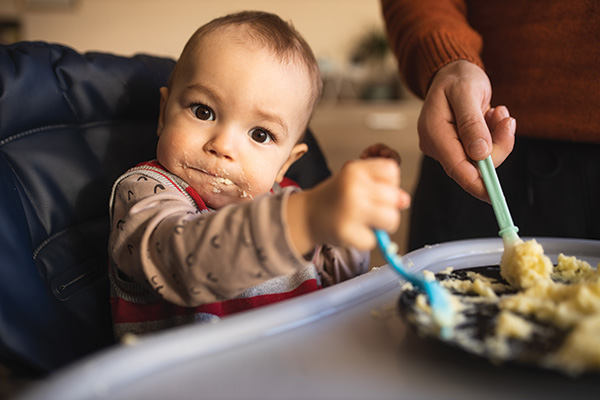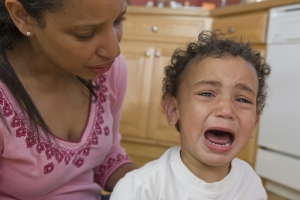Carol D’Agnese is afraid of cheese, milk and anything else that comes from a cow. It is an odd phobia, but D’Agnese has every reason to fear dairy products. Her son, Luke, was nearly killed by a piece of ordinary American cheese.
“At our house, milk is like kryptonite,” D’Agnese says. “When my son was 11 months old, I gave him a piece of American cheese and he went in to anaphylaxis. His face and lips swelled. He couldn’t breathe. When we got him to the hospital, they told me he had allergies.”
Milk turned out to be just one of several severe allergies D’Agnese’s son brought home. Luke is deathly allergic to milk, eggs, peanuts and tree nuts. At 5 years old, he has recently outgrown a severe allergy to soy. If he eats any of these things, or if he merely has skin contact with some of them, his body reacts so severely that he could die.
All About Food Allergies
To the D’Agnese family and 2 million other families like them, first contact with an allergen can be terrifying. When a body mistakes an ordinary food for a germ, the immune system gets busy creating immunoglobulin (IgE) antibodies to the food. The next time that food is encountered, the IgE antibodies sense it and signal the immune system to flood the body with chemicals and histamines. These chemicals cause an allergic response in the respiratory, gastrointestinal, cardiovascular and skin systems.
Signs of an allergy include tingling in the mouth, swelling of the tongue or throat, rashes, eczema, hives, vomiting, cramping and diarrhea, wheezing and difficulty breathing. Generally symptoms appear within one minute to two hours after exposure to the allergen. Severe symptoms warrant a call to 911.
Visiting an allergist is also important to determine the cause of the reaction, since a reaction to a second exposure may be more severe. The most severe reaction is anaphylaxis, in which all systems are affected and overwhelmed. Anaphylactic shock can result in death.
While pediatricians can diagnose many allergies, there are times when visiting an allergist can be helpful, according to Seema Aceves, M.D, an allergist at Rady Children’s Hospital. “If there’s any doubt about an allergy diagnosis, it is worth seeing an allergist,” Dr. Aceves says. “Or, if you already know you have an allergy and think you’ve outgrown it, then you should see an allergist. If the level of allergy has gotten low enough, you can go through a food challenge.”
A food challenge is a clinical trial in which a patient is given a small amount of an allergen, either openly in food, or in a secret “double-blind, placebo” challenge in which the allergen is hidden in an unrelated food. Food challenges can safely show whether the patient’s body still reacts to an allergen.
Diagnostic allergy tests include a prick test, in which an allergen is spread on the skin and the skin is pricked with a special instrument, confirming an allergy by causing the area with the allergen to swell to a certain size within 15 minutes. Blood tests—either the RAST (radioallergosorben test) or a CAP ELISA (enzyme linked immunosorbent assay)—can also show the amount of IgE antibodies the body has produced in response to certain foods. The foods most likely to cause an allergic reaction are milk, eggs, peanuts, soy, wheat, tree nuts (such as almonds, pecans, walnuts and Brazil nuts), fish and shellfish.
The only treatment for food allergies is strict avoidance. While there is no cure for food allergies yet, children sometimes outgrow food allergies. More research is needed to determine the causes and possible future cures for food allergies.
The Challenges of Daily Living
Families of food-allergic children face many challenges in day-to-day living, in shopping, cooking and feeding their entire families. They must learn to read food labels and recognize the scientific terms for allergens. For example, albumen (an egg protein) might be listed instead of egg. They must find resources for allergen-free foods and be assertive with restaurant staff, school authorities and recreation leaders to ensure their children’s safety. They must be well versed in emergency rescue techniques should their child accidentally come into contact with the allergen. And they must protect and educate their children about their allergy in developmentally appropriate ways so they are empowered to protect themselves.
Ages and Stages With Allergies
While some children outgrow some food allergies, many allergies simply change over time. Sue Wagner was on the phone with the doctor’s office when she was given her son’s diagnosis of allergies to peanuts, mustard, eggs, wheat, milk, soy and tree nuts.
“He was 10 months old, still nursing, and scheduled to eat a solid-food meal,” Wagner says. “I got off the phone and thought, I know what he can’t eat, but what can he eat?”
Nursing mothers must not only eliminate allergens from their child’s food, they must radically alter their own diets to avoid passing the allergen through breast milk. They must find ways to get proper nutrition while avoiding the allergen, such as taking calcium supplements if they are unable to drink milk.
Once the baby is weaned and becomes a toddler, the challenges do not diminish—they just change.
“When they’re little, you follow them around everywhere,” D’Agnese says. The biggest danger for toddlers is accidental ingestion, the uneducated parent at playgroup who offers the child a piece of cheese or the peanut butter sandwich left unattended and low enough for a toddler to reach. Hazards abound for all toddlers, but for toddlers with multiple food allergies, danger is everywhere.
Danger and independence are paired in preschool, as well. It is vital that parents be assertive in training schools to handle allergy emergencies, according to D’Agnese.
“When Luke was 4 and at school, he had something with milk and eggs in it. I had trained the school, and they did exactly the right thing with the EpiPen epinephrine injector.” D’Agnese’s training session with the school paid off. The EpiPen injected a dose of epinephrine and saved her son’s life.
When children reach school age, it is most important to teach them to protect themselves. Helping children understand their allergy is important, as is giving them skills to manage their allergy.
“The bottom line is that it stops with the kid and the parent,” D’Agnese says. “My son knows his limits and what he can and cannot do. We want to give kids tools and strategies so they feel empowered.”
Empowering teenagers with food allergies is also essential, according to Lynda Mitchell, founder of the non-profit online support network, Kids with Food Allergies. Because of teens’ risk-taking behaviors and eagerness for an independent identity, Mitchell says, “Teenagers are the group most at risk for having a severe allergic reaction.”
If parents do their job right, however, D’Agnese believes teens can be educated and ready to handle the challenge of living independently with a food allergy.
Finding Resources
Finding kindred souls and supportive resources early on is a crucial part of managing a food allergy for both parents and children. Faced with the challenge of feeding herself and an infant son with so many allergies, Wagner went online to look for resources. Kids with Food Allergies helped Wagner build skills and contacts. From the connections she made at that site and others, Wagner learned how to use allergen-free building blocks to create meals.
“I started with the basic building blocks: starch, protein and vegetables,” Wagner says. “He could eat pork and chicken—there’s the protein. He could eat rice—there’s the starch. And a lot of vegetables.”
Kids with Food Allergies is just one of several online support groups that provide recipes, menus and strategies for daily living with food allergies. And business is booming. Mitchell began Kids with Food Allergies in 2005, and her organization has grown to more than 8000 members.
“Nationwide, there are 75-100 locally-based support groups,” Mitchell says. “Eighty percent of our members have no local groups—even New York City has no local support group. Most groups are the brainchild of a parent of a child with a food allergy, and they are the people who need the most support and are least likely to be able to run a group.”
D’Agnese was just such a parent. When no support groups were available in San Diego, she and Wagner started their own group, the San Diego Food Allergy Support Group. Eighty families now belong.
Monthly meetings include speakers such as medical doctors and nutritionists who can help parents develop skills and knowledge. Networking and sharing information on local resources including stores, products and restaurants, are also important.
“You read about things online, and then you can’t find them locally,” Wagner says. “But someone in the [local] group can always tell you where to get hooked up.”
“None of us asked to come to this party,” D’Agnese says of her status as a parent of a food-allergic child. “But when you get education, you feel so much better.” And that sort of empowerment may be just what the doctor ordered.
|
Resources The San Diego Food Allergy Support Group (www.sandiegofoodallergy.org) offers monthly support meetings, online information, and lectures on food allergies.
The San Diego Food Allergy Support Group will meet on Wednesday, May 23 to host Dr. Michael J. Welch, M.D. of the Allergy and Asthma Medical Group and Research Center in a lecture discussing “The Nuts and Bolts of Food Allergy and an Update on Current Food Allergy Research.” For more information, contact the group at www.sandiegofoodallergy.org. |
--------------------
Cynthia Jenson-Elliott is a freelance writer and mother of two. She lives in the Clairemont area of San Diego with her family.










